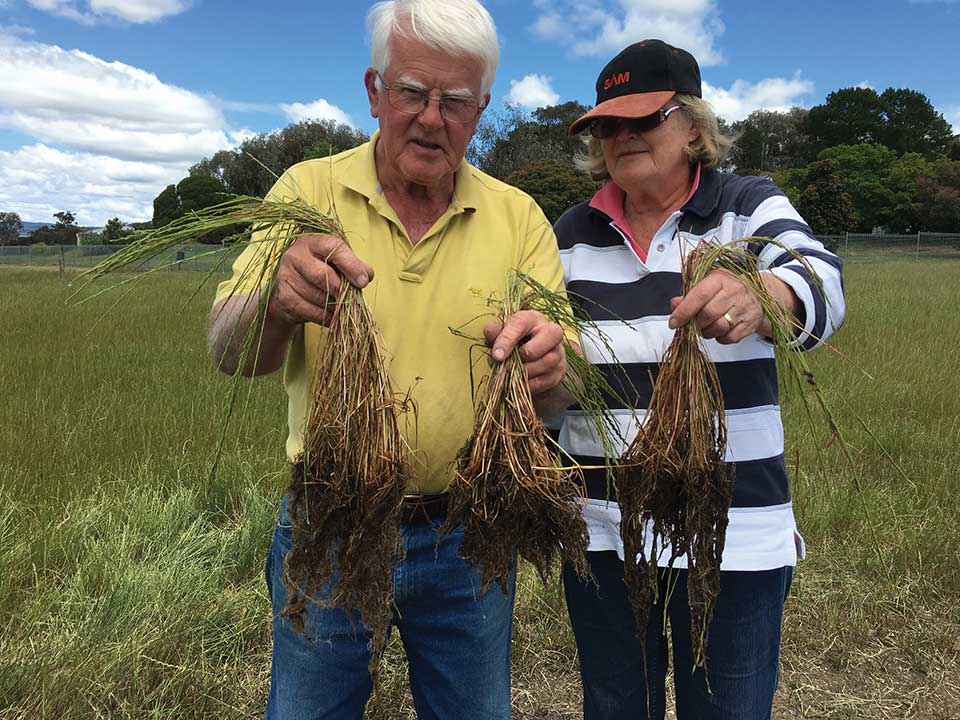Victorian Landcare Magazine - Spring 2018, Issue 73

Warrenbayne-Boho Land Protection Group
Four farms in the Warrenbayne Boho Land Protection Group (WBLPG) area have participated in a trial to capture airborne nutrients in the soil through soil aeration and the use of biological amendments extracted from earthworm compost.
The community farm trials came about in response to soil health decline, soil acidity and poor pasture growth in this area of north east Victoria. The trials were part of the Goulburn Broken CMA’s Beyond-SoilCare project. The objectives of the trials were to double soil carbon, soil depth and pasture growth while reducing soil acidity, in one year.
Trial sites of approximately 1.5 hectares were established on each of the four properties in January 2017. Each site included a plot for the aeration treatment, a plot for the aeration and biological amendment treatment, and a control. Each treatment plot was separated by a 10-metre buffer zone.
The soil was aerated by using a modified Wallace-style aeration plough. Often confused with deep ripping, aeration is achieved when the plough’s aeration slippers pass beneath the soil surface. This raises the level of the soil and creates an air-tunnel at a depth of about 250 millimetres. It also shatters any compacted layers of soil above the tunnel. The finely shattered soil provides the existing soil microbes with oxygen for ‘nitrogen-binding’ and gives the roots unrestricted passage for rapid growth.
Two of the trial farms were cattle properties with a history of high fertiliser use. Two sheep enterprises that had used minimal farm inputs and artificial fertilisers in recent times were also involved.
"The objectives of the trials were to double soil carbon, soil depth and pasture
growth while reducing soil acidity, in one year."
Dramatic results on cattle properties
Results at Peter and Meg Johnson’s cattle property Glen Shee showed an exceptionally heavy crop of high-quality annual rye grass on the trial plot where aeration and biological amendments had been applied. Before the trial began in January 2017 the soil profile had high extractable aluminium (which is toxic to plants) and low pH levels. Aeration and biological amendments produced a 116 per cent increase in pasture in one year compared to the control. Peter and Meg Johnson were pleased with the results.
“The aeration and application of biology (amendments extracted from earthworm compost) did add to the pasture growth. However, we don’t have an aeration plough, so we will only use biology on our pastures in the future,” Peter said.
The results on Ken and May Heywood’s cattle property Trevista showed a lack of vigorous root and hair-root development below 120 millimetres and that bacterium below this level in the soil profile were ‘stressed.’ This was revealed in laboratory tests. Microbial presence in the 0–100 millimetre depth range enhanced nutrient recycling and enabled root development, while in the 100–200 millimetre depth range this was not the case due to the ‘stressed’ bacteria.
Ken Heywood is planning to continue the trials by using an aerator plough and added biology. He is going to hold off on applying other additives and observe the ongoing results.
"The journey towards understanding the processes that encourage healthy soils, independent of artificial fertilisers, has begun."
Value as soil and pasture sweetener
Marg Davis believes that soil aeration and biological amendments have shown value for sweetening the pasture on her sheep property, Hillside Manor, by developing soil roots and soil structure at depth.
The soils on the property below 120 millimetres had plot-aggregated extractable aluminium levels consistently greater than 80 parts per million and soil acidity at pH 5.1 before the trial began in January 2017. The most striking finding after the trial was the vigorous root and hair-root development below 120 millimetres despite the high extractable aluminium levels. This vigorous root and hair-root development and related pasture growth is attributed to the aggregated treated plot pH rising to pH 5.5 (less acidity) and neutralising the toxic levels of the extractable aluminium.

Above: Dreadlock roots were evident in samples taken from Hillside Manor at Warrenbayne, near Violet Town, in July 2017.
“The biological amendments have also had the effect of sweetening up the pasture, and a massive reduction in earth-mites,” Marg said.
Results on Drusilla and Ethne Green’s sheep property Spion Kopje saw vigorous root and hair-root development along the aeration lines where toxic levels of extractable aluminium were consistently greater than 100 parts per million and the trial plot aggregated soil acidity was at pH 4.9. The vigorous root and hair-root development along the aeration lines is attributed to higher localised pH values (less acidity) in the root zones along the aeration lines.
No artificial fertiliser had been applied at Spion Kopje for the past ten years so the property acted as a blank slate.
Members of the WBLPG, including those involved in the early trials, hope to obtain further grants to extend the research and to purchase an aeration plough so the local farming community can evaluate the benefits of aeration and biological amendments for their properties.
The journey towards understanding the processes that encourage healthy soils, independent of artificial fertilisers, has begun.
Dr John Russell is an Agricultural Engineer from La Trobe University and Ethne Green is the secretary of the WBLPG.
To see the full reports for each of the four farms go to the Gecko CLaN's website https://www.geckoclan.com.au/group/warrenbayneboho-land-protection-group/ or email Dr John Russell at jvrussell100@gmail.com
Access the magazine's index to search for other stories by author, title, and subject, here.

Above: